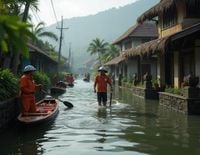As the sun rose over the Indonesian archipelago on September 11, 2025, two of its most renowned provinces—Bali and East Nusa Tenggara—were in the throes of a disaster that would test the mettle of their people and the resilience of their communities. Torrential rains, beginning on September 9, unleashed catastrophic flash floods and landslides, sweeping away homes, businesses, and lives in their wake.
According to the Associated Press, rescuers in Bali and East Nusa Tenggara recovered the bodies of 15 people lost to the disaster, while 10 others remained missing as of Wednesday. The devastation was widespread: in Mauponggo village, Nagekeo district, East Nusa Tenggara, a mother and her child were found buried under mud. In the neighboring Loka Laba village, another victim was found, bringing home the personal tragedies behind the statistics. Earlier, three members of a family were washed away when their house collapsed, with four others still unaccounted for in Mauponggo.
Bali, Indonesia’s tourism crown jewel, was not spared. The National Disaster Mitigation Agency reported that the body of a woman was recovered near Badung market in Denpasar, the island’s bustling capital. Six people remained missing. Eight additional bodies were discovered earlier, including four individuals swept away with a building in the Kumbasari market area of South Denpasar, as reported by Nyoman Sidakarya, head of Bali’s Search and Rescue Agency.
Floodwaters breached riverbanks, sweeping away cars and submerging homes and marketplaces. Videos released by the National Search and Rescue Agency painted a grim picture: cars floating in muddy water, soldiers and rescuers in rubber boats evacuating children and elderly people stranded on rooftops. According to Bali’s disaster management agency, nine cities and regencies across the island were ravaged, with at least 112 neighborhoods inundated. Landslides were triggered, roads and bridges damaged, and 15 shops and residences destroyed. The floodwaters reached up to 2.5 meters in some places, forcing more than 800 people into temporary shelters.
Governor of Bali Wayan Koster did not mince words about the scale of the crisis. “This disaster also caused material losses for traders and tourism businesses,” he said, highlighting the blow to livelihoods and the island’s economic lifeline—tourism. Authorities were forced to cut electricity and water across wide swathes of the island, leaving hotels, restaurants, hospitals, and public facilities to run on generators. The disruption was palpable: streets were dotted with overturned vehicles and scattered household items as the waters began to recede by Thursday, and gridlock paralyzed key tourist destinations.
East Nusa Tenggara, meanwhile, faced its own harrowing ordeal. Flash floods in Nagekeo swept away entire villages and vehicles, blocked three major roads, killed at least six people, and left four missing. Two bridges, two government offices, crop fields, farms, and livestock herds were destroyed, compounding the misery for communities already grappling with loss. Local Disaster Mitigation Agency head Agustinus Pone described how the severe weather and rugged terrain hampered rescue efforts, noting that landslides had further isolated affected areas.
The government’s response was swift. Indonesian President Prabowo Subianto directed the National Disaster Management Agency (BNPB) to lead relief efforts, providing vital supplies like food, tents, blankets, mattresses, and water pumps to the worst-hit areas. Rubber boats were deployed for evacuation and rescue operations, aiming to ensure timely assistance for those in peril. According to Devdiscourse, the BNPB has worked tirelessly to stabilize the situation and address the immediate needs of both locals and the island’s many visitors.
Bali’s predicament is particularly acute given its status as a global tourism hotspot. The island was recently crowned Asia’s most beautiful destination in the 2025 Reader’s Choice Awards by DestinAsian magazine, and in 2024, it welcomed over 6.3 million international visitors—surpassing pre-pandemic levels. Tourism authorities have set their sights even higher for 2025, with a target of 6.5 million visitors. Yet, the floods have thrown a wrench into these ambitions, raising questions about the long-term impact of natural disasters on travel patterns and the local economy.
The disruption to Bali’s tourism industry is more than a temporary setback. As VNA noted, the floods have caused “huge damage to livelihoods, to traders, and to tourism, the economic lifeline of the island.” With so much at stake, the local government has made it clear that the safety and well-being of residents and visitors must come first. Recovery efforts are focused not only on restoring normalcy and essential infrastructure but also on safeguarding the island’s reputation as a safe and reliable destination.
While the immediate focus remains on rescue and relief, the disaster has also shone a spotlight on Indonesia’s vulnerability to natural calamities. Heavy seasonal rains from September through March regularly cause flooding and landslides across the archipelago. This year’s extreme events, as reported by multiple agencies, are a stark reminder of the challenges facing communities in a changing climate. The frequency and severity of such disasters raise urgent questions about climate preparedness and the need for resilient infrastructure, especially in regions so dependent on tourism.
As recovery operations continue, the search for survivors goes on. Rescuers are working around the clock, combing through mud and debris in the hope of finding those still missing. The region’s rugged terrain and ongoing severe weather have made these efforts perilous and slow. Yet, the resolve of the Indonesian people—bolstered by government support and international attention—remains unbroken.
For Bali and East Nusa Tenggara, the path to recovery will be long and fraught with challenges. The floods have left scars not only on the landscape but also in the hearts of those who lost loved ones, homes, and livelihoods. But as the waters recede and the cleanup begins, there is hope that these communities, with their famed resilience and spirit, will find a way to rebuild stronger than before.
Indonesia’s latest disaster is a sobering lesson in the power of nature and the importance of preparedness. It is also a testament to the enduring strength of communities united in the face of adversity—determined, against all odds, to reclaim their future.






